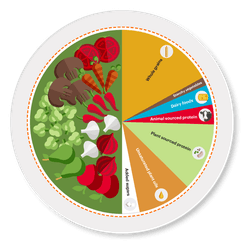
Transformation of the global food system is urgently needed say today’s findings from the EAT-Lancet Commission, which draws on the Oxford Martin School’s study on feeding 10 billion people within planetary boundaries as well as research from other leading experts in nutrition, agriculture, food policy and climate science
More than three billion people are classed as malnourished, which includes both people who are undernourished and overnourished - leading to obesity. At the same time, food production is driving climate change, biodiversity loss, pollution due to over-application of nitrogen and phosphorus fertilizers, and unsustainable water and land use.
The EAT-Lancet Commission has launched the first scientific targets for a healthy diet from a sustainable food production system that operates within planetary boundaries - thresholds beyond which Earth’s vital systems could become unstable. The report promotes a ‘flexitarian’ diet, which is largely plant-based with unsaturated rather than saturated fats but can optionally include modest amounts of fish, meat, dairy and added sugars. The authors estimate that widespread adoption of such a diet would improve intakes of most nutrients and deliver major health benefits whilst also combatting climate change and biodiversity loss if suggestions for the sustainable intensification of nutrient-rich crops and improvement of global food systems are acted upon.
Dr Marco Springmann of the Oxford Martin Programme on the Future of Food, who co-authored the report said, “Without concerted action, we found that the environmental impacts of the food system could increase by 50-90% by 2050 as a result of population growth and the rise of diets high in fats, sugars and meat. In that case, all planetary boundaries related to food production would be surpassed, some of them by more than twofold. Many of the solutions we analysed are being implemented in some parts of the world, but it will need strong global coordination and rapid upscale to make their effects felt.”
Individual action is also necessary. Global adoption of the new recommendations by 2050 will require global consumption of foods such as red meat and sugar to decrease by more than 50%, while consumption of nuts, fruits, vegetables, and legumes must increase more than two-fold. The change could be even more significant depending on where people live – for example, countries in North America eat almost 6.5 times the recommended amount of red meat, while countries in South Asia eat only half the recommended amount. All countries are eating more starchy vegetables (potatoes and cassava) than recommended, with intakes ranging from between 1.5 times above the recommendation in South Asia and by 7.5 times in sub-Saharan Africa.

This image shows what a planetary health plate should look like. By volume approximately half a plate should be vegetables and fruits; the other half, displayed by contribution to calories, should consist of primarily whole grains, plant protein sources, unsaturated plant oils, and (optionally) modest amounts of animal sources of protein.
The report emphasises that key to enabling this shift is ensuring that healthy diets are accessible and affordable to all, with social protections to ensure low-income groups are not adversely affected by any rises in food prices.
The EAT-Lancet Commission is a three-year project that brings together 37 experts from 16 countries with expertise in health, nutrition, environmental sustainability, food systems, economics and political governance. Research findings from Professor Sir Charles Godfray, Director of the Oxford Martin School, and Dr Tara Garnett, of the Oxford Martin Programme on the Future of Food and the LEAP project, also contributed to the science evidence base of the report.